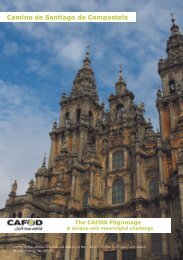baptism confirmation first holy communion - Roman Catholic ...
baptism confirmation first holy communion - Roman Catholic ...
baptism confirmation first holy communion - Roman Catholic ...
Create successful ePaper yourself
Turn your PDF publications into a flip-book with our unique Google optimized e-Paper software.
2. The two-stage celebration<br />
A common practice in parishes is that on the <strong>first</strong> Sunday of the month parents present their<br />
children for the ceremony of welcoming and pre-<strong>baptism</strong>al anointing, normally at the back of<br />
the church (another appropriate location in the building may be used, but there is something<br />
symbolic about children being presented on the threshold of the church building). If godparents<br />
can be present, so much the better. Parents who are regular churchgoers will present their<br />
children at the Mass they normally attend. In other cases, the <strong>baptism</strong> preparation team may<br />
need to discuss with the parents which of the weekend Masses would be the most suitable for<br />
them to come to for this purpose.<br />
In this model, the actual <strong>baptism</strong>s will take place on the last Sunday of the month:<br />
o either at the weekend Mass that the parents normally attend, if that is the normal<br />
practice,<br />
o or on Sunday afternoon, together with the families of all other children to be<br />
baptised that month. In the latter case, there should be an open invitation to all<br />
members of the church community also to be present.<br />
In the case of a Sunday afternoon celebration, all members of the <strong>baptism</strong>al preparation team<br />
are present if possible. In addition, it is extremely helpful to the celebration if music is used – at<br />
least a cantor and an instrumentalist are highly recommended. In addition to joyful and wellknown<br />
hymns, there can be sung alleluias or other acclamations after each individual child has<br />
been baptised. The aim is to give the families not only a sense of church community but also a<br />
meaningful and joyful experience which may encourage the return of those who are not regular<br />
churchgoers.<br />
3. Symbols in the rite<br />
Oil of Catechumens, used in the pre-<strong>baptism</strong>al anointing as a symbol of strengthening and<br />
preparation.<br />
Water, a symbol of cleansing and of life.<br />
Oil of Chrism, used in the post-<strong>baptism</strong>al anointing, announcing the anointing with Chrism<br />
which will take place at Confirmation (CCC 1242)<br />
Clothing with a White Garment, a symbol of new life in Christ. Traditionally this is a white shawl<br />
which is placed around the child at the relevant point in the ceremony.<br />
Baptismal Candle, to symbolise the flame of faith in Christ. It is very appropriate that this candle<br />
should be preserved for subsequent use at the child’s First Holy Communion.<br />
9
















